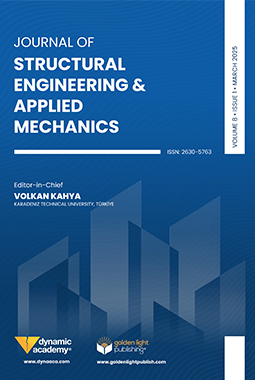ISSN:2630-5763
Journal of Structural Engineering & Applied Mechanics
ARTICLES
Ayodele Akin-Adamu
Çağlar Yalçınkaya
Onur Merter
The Microplane and Menetrey-Willam concrete models are formulated on the research work of Bazant and Gambarova and Menetrey-Willam in the nineties respectively. They are used in this thesis to predict how reinforced Ultra-High-Performance Concrete (UHPC) beams will behave when subjected to flexural and shear dominant loadings. The numerical models are available in ANSYS, and they can simulate UHPC's extraordinary mechanical properties, such as high compression and tension strength, strain hardening, and softening behavior in compression and tension. In this research, four UHPC beams with dimensions of 180 wide by 270 deep by 4000 mm long with tensile reinforcements were studied using the two cementitious composite models mentioned above with the ANSYS software. The beams were investigated under flexural four-point loading and shear three-point loading with the ANSYS program. A quarter-geometric section model of the full beam was considered for the four-point loading to take advantage of symmetry in the longitudinal and transverse directions of the beam. For the three-point loading, the full geometry model of the beam was considered only because of the lack of symmetry. The results from the ANSYS finite element software were validated with an experimental study conducted by different researchers to show its capacity to predict the bending and shear behavior of reinforced UHPC beams. The comparisons of the results of both material models show that they can simulate the behavior of UHPC beams by using experimental load-deflection plots of the beam specimens and force strain plots of the longitudinal tensile reinforcements in the sample beams.
https://doi.org/10.31462/jseam.2024.03148171
Casim Yazıcı
Muhammed Gürbüz
This study focuses on the experimental and numerical investigation of cold-formed steel (CFS) beams with web perforations to assess their shear performance. Twelve samples were tested, all processed from high-strength, cold-formed steel sheets of grade S235 with a thickness of 1.5 mm. The specimens, designated as CC, were formed by interlocking two C-sections and welded together. Various parameters were analyzed, such as the shear-span ratio, hole depth-to-web height ratio (dh/h), and web height-to-thickness ratio. The experimental setup involved mid-span single-point loading conditions to evaluate the mechanical behavior of the beams. Circular holes with different diameters were strategically placed at the mid-height of the webs in two shear zones. The experimental results were validated using finite element analysis (FEA) conducted in ANSYS, ensuring the accuracy of the finite element model. The findings indicate that the ultimate bearing capacity of the specimens decreases as the hole depth-to-web height ratio increases. When the hole depth-to-web height ratio was small (dh/h ≤ 0.4), the load-deflection curves declined rapidly after reaching the peak. Conversely, for a ratio of 0.5, the curves declined more gradually. Additionally, mid-span deflection decreased as dh/h increased, with significant variation observed for smaller ratios and stabilization for a ratio of 0.5. This research provides a comprehensive understanding of the shear behavior of cold-formed steel beams with web openings. It offers valuable insights into the design and optimization of these structures, contributing to the safe and efficient application of CFS beams in various engineering contexts.
https://doi.org/10.31462/jseam.2024.03172185
C.C. Hong
The effects of third-order shear deformation theory (TSDT) and varied linear shear correction coefficient on the vibration frequency of thick functionally graded material (FGM) plates with fully homogeneous equations under thermal environment and power law are investigated. The nonlinear coefficient c_1 term of displacement field of TSDT is included in the fully homogeneous equation under vibration of FGM plates. The determinant of the coefficient matrix in dynamic equilibrium differential equations under vibration can be represented in the fully fifth-order polynomial equation, thus the natural frequency can be found. The natural frequency with/without the nonlinear c_1 term of displacement fields is investigated. It is a significant novelty with the consideration of the nonlinear c_1 term in the frequency computation.
https://doi.org/10.31462/jseam.2024.03186197
Enes Miraç Karadag
Mustafa Gurocak
Ceren Kına
Kazim Turk
Although concrete has high compressive strength values, it has a heavy unit volume and low tensile strength. In this study, the normal-weight aggregate, which takes up the most space in concrete by volume and mass, was partially replaced with pumice aggregate, and macro steel fiber (30 mm) was also added to the mixtures. This experimental work aims to investigate the effect of pumice aggregate amount on the fresh and hardened properties, as well as the flexural performance of the self-compacting lightweight concrete (SCLC). The replacement proportions of pumice aggregate with crushed sand were arranged as 45%, 50%, and 55% of the entire aggregate by weight. Three mixtures, each with 1% macro steel fiber reinforcement and without fiber, were prepared for each mixture scenario. The mix design of these six mixtures was arranged to achieve the self-compacting ability and the workability tests recommended by EFNARC (slump-flow, T50, J-ring) were taken into account. To investigate the mechanical properties (compressive, splitting tensile, and flexural strengths) and flexural toughness of the samples, the specimens were cured in water at 23±2 °C for 28 days. As a result, the unit volume weights of the specimens produced from pumice-substituted mixtures decreased with the increase in the pumice dosage, while the compressive, splitting tensile, and flexural strengths decreased. However, it has been determined that all SCLC mixtures including pumice aggregate provided workability properties in general and had enough compressive strength to be used in the production of structural bearing elements, regardless of fiber content. As a result, the optimum pumice aggregate replacement percentage with crushed sand was found to be 45% and the best flexural performance values of the specimens having macro steel fiber were observed in the ones having 45% pumice aggregate substitution.
https://doi.org/10.31462/jseam.2024.03198218


